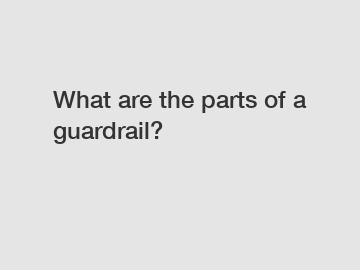What are the parts of a guardrail?
What are the parts of a guardrail?
Have you ever wondered about the intricate design and composition of a guardrail? From highways to bridges, these sturdy safety features are essential in safeguarding vehicles and preventing accidents. Understanding the different parts that make up a guardrail can give us insights into how they work and contribute to road safety. So, let's delve into the various components of a guardrail and explore their functions.
1. Posts:

The posts are the backbone of a guardrail system. Typically made of strong materials like steel or concrete, these vertical supports are securely installed into the ground. Their primary purpose is to provide stability and resilience to the guardrail, ensuring it can withstand high impact forces during collisions. Posts are usually spaced at regular intervals along the roadside, providing the necessary support for the other components of the guardrail.
2. Rails:
The rails horizontally connect the posts and are crucial in absorbing and redirecting the kinetic energy of a colliding vehicle. Guardrail rails are composed of galvanized steel, which enhances their durability and resistance against rust and corrosion. The rails are designed to flex upon impact, effectively dissipating the force generated by the crashing vehicle. This flexing motion helps absorb and distribute the energy, reducing the severity of the impact and minimizing the risk of injury.
3. Blockouts:
Blockouts are small rectangular pieces of material inserted between the rail and the post. They provide additional strength and support to the guardrail system. By filling the space between the rail and the post, blockouts prevent the rail from wrapping around the post during a collision. This helps maintain the integrity of the guardrail, ensuring it remains effective in protecting drivers and passengers.
4. End Treatments:
At the beginning and end of a guardrail system, special components called end treatments are utilized. These are designed to enhance safety further by preventing the rail from impaling or spearing vehicles that hit the end of the barrier. End treatments can come in various forms, such as energy-absorbing terminal systems or flared ends, all aimed at reducing the potential for severe injuries in the event of a crash.
5. Reflectors:
Reflectors are essential features of a guardrail system, especially during nighttime or low visibility conditions. These small, reflective devices are strategically placed along the guardrail to enhance its visibility, helping drivers stay on the correct side of the road and navigate safely. Reflectors serve as a visual guide, ensuring that motorists can easily identify the presence and position of the guardrail, reducing the risk of accidental collisions.
In conclusion, guardrails are a vital component of road safety, protecting drivers and passengers from life-threatening accidents. By understanding the different parts of a guardrail, we can appreciate how each component contributes to its overall effectiveness. From the sturdy posts that provide support and stability to the flexing rails that dissipate energy, every element plays a vital role. Additionally, blockouts ensure the guardrail system remains secure, while end treatments and reflectors enhance safety measures. It is only through the collaboration of these various parts that guardrails can fulfill their purpose of safeguarding lives on the roads. So, next time you pass by a guardrail, take a moment to recognize the complexity and design ingenuity behind this seemingly simple barrier.
For more highway guardrail for Vietnam, Wuhan Dachu Traffic Facilities Co., Ltd., bridge guardrailsinformation, please contact us. We will provide professional answers.


